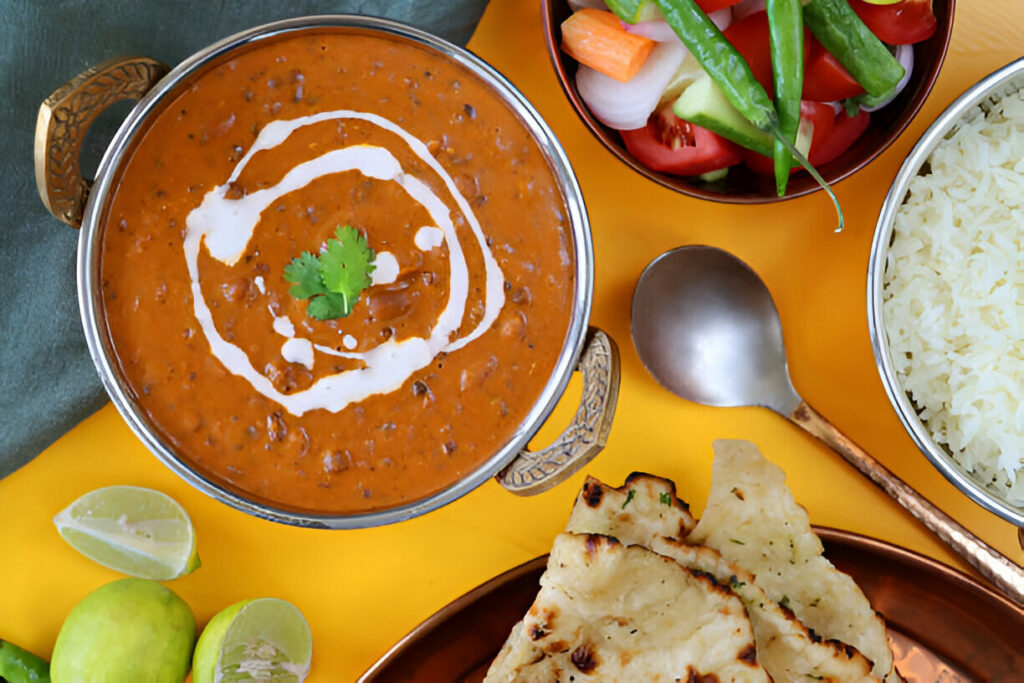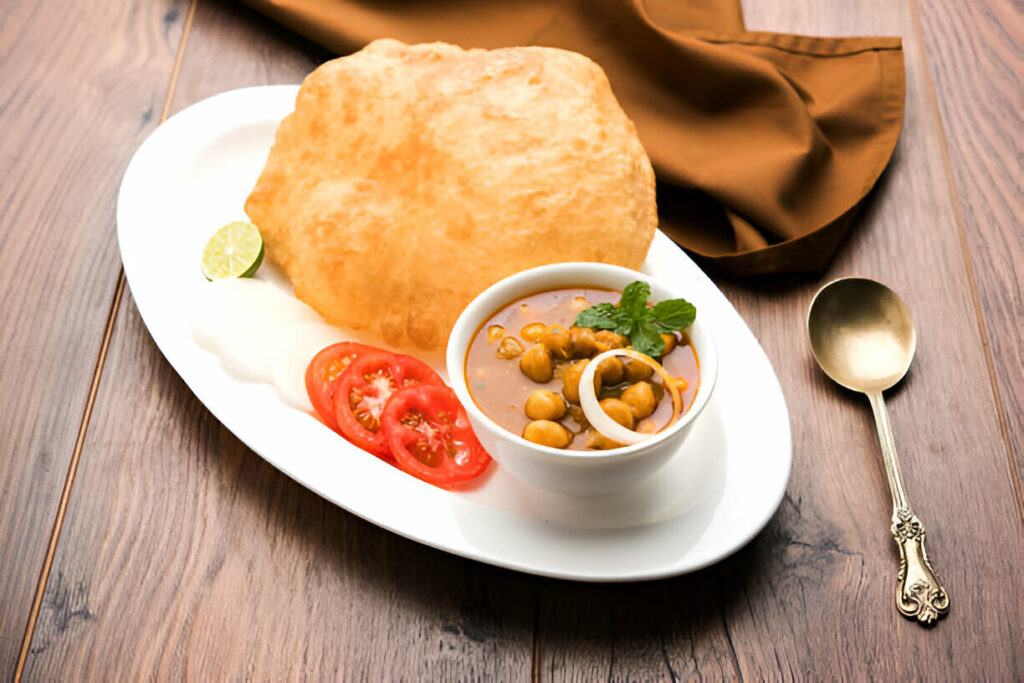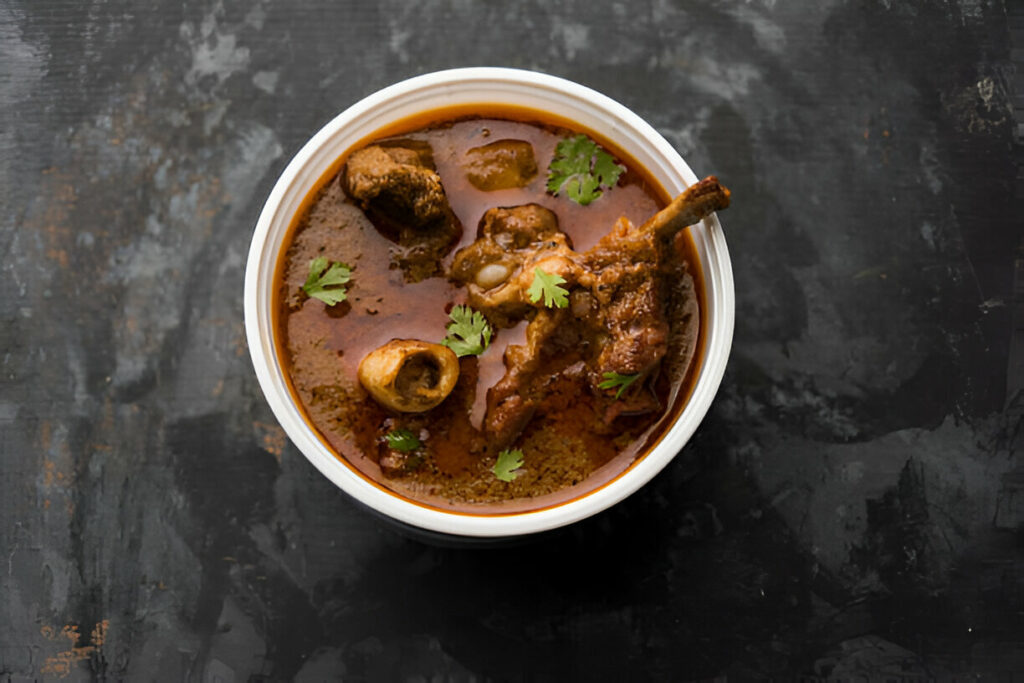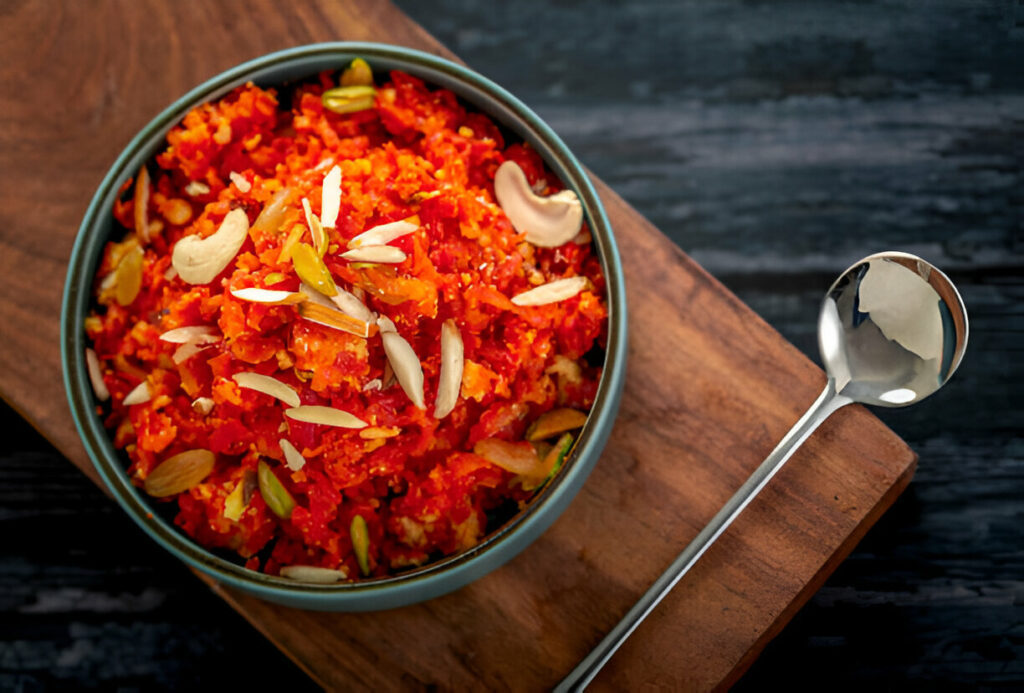North Indian
Indian Cuisines
Palak Paneer
Palak Paneer is a popular North Indian dish that consists of paneer (Indian cottage cheese) cubes cooked in a creamy spinach (palak) sauce
Daal Makhani
Daal Makhani is a classic North Indian dish known for its rich and creamy texture.
Chole Bhature
Spicy chickpea curry (chole) served with deep-fried bread (bhatura). A popular street food and breakfast dish in North India.
Rogan Josh
Rogan josh is a classic dish from the Kashmiri cuisine of India, known for its rich, aromatic flavors and vibrant red color.
Gajar ka Halwa
Aalso known as Gajrela is a popular and traditional North Indian dessert made from grated carrots, milk, sugar, ghee, and nuts, enjoyed hot or cold.

Palak Paneer
Palak paneer is a popular North Indian dish consisting of paneer (Indian cottage cheese) cubes cooked in a creamy spinach (palak) gravy. The spinach gravy is typically made with pureed spinach leaves, along with various spices such as cumin, coriander, turmeric, and garam masala. It’s known for its vibrant green color and rich, creamy texture, often served with rice or Indian breads like naan or roti. Palak paneer is loved for its nutritious qualities from spinach and the protein from paneer, making it a wholesome vegetarian dish.
- Ingredients
- Method
- 250 grams paneer (Indian cottage cheese), cubed
- 250 grams spinach (palak), washed and roughly chopped
- 1 medium onion, finely chopped
- 2 tomatoes, finely chopped or pureed
- 2-3 cloves garlic, minced
- 1-inch piece of ginger, minced or grated
- 1 green chili, chopped (optional, adjust to taste)
- 1 teaspoon cumin seeds
- 1 teaspoon turmeric powder
- 1 teaspoon coriander powder
- 1/2 teaspoon garam masala powder
- 1/2 cup cream or full-fat yogurt (optional, for creaminess)
- Salt to taste
- 2 tablespoons oil or ghee for cooking
Blanch the Spinach:
- Bring a pot of water to a boil. Add the chopped spinach and blanch for 2-3 minutes until wilted.
- Immediately transfer the spinach to a bowl of ice water to stop the cooking process and preserve the green color.
- Drain the spinach well and blend it into a smooth puree using a blender or food processor. Set aside.
Prepare Paneer:
- Heat 1 tablespoon of oil or ghee in a pan over medium heat.
- Fry the paneer cubes until they turn golden brown on all sides. Remove from the pan and set aside on a plate.
Make the Palak Paneer Gravy:
- In the same pan, add another tablespoon of oil or ghee if needed.
- Add cumin seeds and let them splutter.
- Add chopped onions and sauté until they turn translucent.
Add Aromatics:
- Add minced garlic, ginger, and green chili (if using). Sauté for a couple of minutes until fragrant.
Add Spices:
- Add turmeric powder, coriander powder, and sauté for another minute to toast the spices.
Add Tomatoes:
- Add chopped tomatoes or tomato puree. Cook until the tomatoes are soft and the oil starts to separate from the masala.
Add Spinach Puree:
- Pour in the spinach puree and mix well with the masala.
- Season with salt to taste. Let it simmer for 5-7 minutes on low heat to allow the flavors to blend together.
Add Paneer and Cream/Yogurt:
- Gently add the fried paneer cubes to the spinach gravy. Stir gently to coat the paneer with the spinach mixture.
- Optionally, add cream or yogurt for extra creaminess. Mix well.
Finish and Serve:
- Sprinkle garam masala powder over the palak paneer.
- Cook for another 1-2 minutes, then turn off the heat.
- Serve hot with naan, roti, or rice.

Daal Makhani
Daal Makhani is a popular Indian dish made from black lentils (urad dal) and kidney beans (rajma), simmered in a rich and creamy tomato-based sauce. It’s typically seasoned with garlic, ginger, onions, and a blend of spices such as cumin, coriander, turmeric, and garam masala. The dish often includes butter and cream, giving it a luxurious texture and flavor.
- Ingredients
- Method
- 1 cup whole black lentils (urad dal)
- 1/4 cup kidney beans (rajma)
- 2 tablespoons ghee or butter
- 1 tablespoon oil
- 1 large onion, finely chopped
- 1 tablespoon ginger-garlic paste
- 2 tomatoes, pureed
- 1 teaspoon cumin seeds
- 1 teaspoon red chili powder (adjust to taste)
- 1/2 teaspoon turmeric powder
- 1 teaspoon coriander powder
- 1 teaspoon garam masala
- Salt to taste
- 1/4 cup cream (optional, for a richer texture)
- Fresh coriander leaves for garnish
For Tempering (Tadka):
- 2 tablespoons ghee or butter
- 1 teaspoon cumin seeds
- 2-3 cloves garlic, minced
- 1 green chili, slit (optional)
Preparing the Lentils and Beans:
- Rinse the whole black lentils (urad dal) and kidney beans (rajma) thoroughly under running water.
- Soak them in enough water overnight or for at least 6-8 hours.
Cooking the Lentils and Beans:
- Drain the soaked lentils and beans. Transfer them to a pressure cooker or a large pot.
- Add fresh water and salt. Pressure cook for about 15-20 minutes until the lentils and beans are soft and cooked through. If using a pot, cook until they are tender, adding more water if necessary.
Preparing the Sauce:
- Heat ghee and oil in a pan over medium heat.
- Add cumin seeds and let them splutter.
- Add finely chopped onions and sauté until golden brown.
- Add ginger-garlic paste and sauté for another 1-2 minutes until the raw smell disappears.
- Add tomato puree and cook until the oil starts to separate from the masala (spice mixture).
Adding Spices:
- Add red chili powder, turmeric powder, coriander powder, and garam masala. Stir well and cook for a minute.
Combining Lentils and Sauce:
- Add the cooked lentils and beans to the sauce. Mix well.
- Adjust consistency with water if necessary. Simmer the daal makhani on low heat for 20-30 minutes, stirring occasionally. This helps the flavors to meld together.
Adding Cream (Optional):
- If using cream, add it at this stage and mix well. Simmer for another 5 minutes.
Preparing the Tempering (Tadka):
- Heat ghee or butter in a small pan for tempering.
- Add cumin seeds and let them splutter.
- Add minced garlic and slit green chili. Sauté until garlic turns golden brown.
Finishing Touch:
- Pour the tempering over the daal makhani.
- Garnish with fresh coriander leaves.
Serving:
- Serve hot with naan, roti, or rice.
Enjoy your delicious Daal Makhani! Adjust the spices and cream according to your taste preferences for a perfect blend of flavors.

Chole Bhature
Chole Bhature is a popular North Indian dish consisting of spicy chickpea curry (chole) served with deep-fried bread (bhature). The chickpea curry is cooked with a blend of aromatic spices like coriander, cumin, turmeric, and garam masala, along with onions, tomatoes, and sometimes green chilies for heat. The bhature, a fluffy deep-fried bread made from fermented dough, complements the spicy curry perfectly. This dish is often garnished with fresh cilantro, sliced onions, and a wedge of lemon. Chole Bhature is enjoyed as a hearty breakfast or a satisfying meal any time of the day, especially popular in street food stalls across India.
- Ingredients
- Method
For Chole:
- 1 cup dried chickpeas (or 2 cans of chickpeas, drained)
- 2 medium onions, finely chopped
- 2 medium tomatoes, finely chopped
- 2-3 green chilies, finely chopped
- 1 inch ginger, grated or finely chopped
- 4-5 cloves of garlic, minced
- 1 teaspoon cumin seeds
- 1 teaspoon turmeric powder
- 1 teaspoon red chili powder
- 1 teaspoon coriander powder
- 1 teaspoon garam masala
- 1 teaspoon amchur (dried mango powder)
- Salt to taste
- Fresh coriander leaves for garnish
- Cooking oil
For Bhature (Fried Bread):
- 2 cups all-purpose flour (maida)
- 1/2 cup plain yogurt (dahi)
- 1/2 teaspoon baking powder
- 1/4 teaspoon baking soda
- Salt to taste
- 1 tablespoon semolina (optional, for crispiness)
- Water, as needed
- Oil for deep frying
Preparing Chole:
Soaking Chickpeas: If using dried chickpeas, soak them overnight in water. Drain and rinse thoroughly before cooking.
Pressure Cooking Chickpeas: In a pressure cooker, cook the soaked chickpeas with salt and enough water (about 2 cups) until they are soft and tender. If using canned chickpeas, skip this step and proceed to the next.
Making Chole Masala:
- Heat oil in a large pan or kadhai.
- Add cumin seeds and let them splutter.
- Add chopped onions, green chilies, ginger, and garlic. Sauté until onions are translucent.
- Add chopped tomatoes and cook until they turn soft and oil starts to separate.
Adding Spices:
- Add turmeric powder, red chili powder, coriander powder, and garam masala. Sauté for a minute until spices are fragrant.
Cooking Chickpeas:
- Add the cooked chickpeas (or drained canned chickpeas) to the pan.
- Mix well and simmer for 10-15 minutes on medium heat, stirring occasionally.
- Add amchur powder and adjust salt and spice levels according to taste.
- Mash a few chickpeas with the back of a spoon to thicken the gravy if desired.
- Garnish with fresh coriander leaves and keep the chole warm until serving.
Preparing Bhature:
Preparing Dough:
- In a mixing bowl, combine all-purpose flour, yogurt, baking powder, baking soda, salt, and semolina (if using).
- Knead the mixture into a smooth dough using water as needed. The dough should be soft but not sticky.
- Cover the dough with a damp cloth and let it rest for at least 2 hours.
Shaping and Frying Bhature:
- Divide the dough into equal-sized balls and roll them out into oval or round shapes (about 6-7 inches in diameter and 1/4 inch thick).
- Heat oil in a deep frying pan or kadhai over medium-high heat.
- Carefully slide the rolled out dough into the hot oil. Press gently with a slotted spoon to help the bhature puff up.
- Fry until golden brown and crispy on both sides, flipping once. Remove from oil and drain on paper towels.
Serving Chole Bhature:
- Serve the hot chole with bhature along with sliced onions, lemon wedges, and a side of pickle or green chutney.
- Enjoy this delicious and indulgent North Indian dish!
This recipe serves approximately 4-6 people, depending on serving size. Adjust spices and quantities according to your taste preferences.

Rogan Josh
Rogan Josh is a signature dish of Kashmiri cuisine, featuring tender meat (usually lamb or mutton) slow-cooked in a blend of yogurt and aromatic spices. Its vibrant red color comes from Kashmiri red chili powder and a final drizzle of “rogan” (infused oil). This flavorful dish is known for its complex flavors and is often served with steamed rice or naan, making it a favorite for special occasions and gatherings, embodying the rich culinary heritage of the region.
- Ingredients
- Method
- 500 grams lamb or mutton, cut into pieces
- 3 tablespoons oil
- 2 onions, finely chopped
- 2 tomatoes, pureed
- 1 tablespoon ginger-garlic paste
- 1 teaspoon cumin seeds
- 2-3 green cardamom pods
- 2-3 cloves
- 1-inch cinnamon stick
- 1 bay leaf
- 1 teaspoon turmeric powder
- 2 teaspoons Kashmiri red chili powder (adjust to taste)
- 1 teaspoon ground fennel seeds
- 1 teaspoon ground ginger powder
- 1 teaspoon ground coriander
- 1/2 teaspoon garam masala
- Salt to taste
- Fresh coriander leaves for garnish
For the Rogan (Red Oil):
- 3 tablespoons oil
- 1/2 teaspoon Kashmiri red chili powder
Marinating the Meat (Optional):
- You can marinate the meat in yogurt, salt, and a little turmeric powder for about 30 minutes to 1 hour for added flavor and tenderness.
Cooking the Rogan Josh:
- Heat oil in a heavy-bottomed pan or pressure cooker over medium heat.
- Add cumin seeds, green cardamom pods, cloves, cinnamon stick, and bay leaf. Sauté for a few seconds until aromatic.
- Add chopped onions and sauté until golden brown.
Adding Ginger-Garlic Paste and Spices:
- Add ginger-garlic paste and sauté for 1-2 minutes until the raw smell disappears.
- Add turmeric powder, Kashmiri red chili powder, ground fennel seeds, ground ginger powder, ground coriander, and salt. Mix well and cook for another 1-2 minutes.
Cooking the Meat:
- Add the lamb or mutton pieces to the pan. Stir well to coat the meat with the spice mixture.
- Cook the meat on medium-high heat until it is browned on all sides.
Adding Tomato Puree:
- Add the tomato puree and mix well. Cook for 5-7 minutes, stirring occasionally, until the oil starts to separate from the masala.
Simmering:
- If using a pressure cooker, add water as needed (about 1/2 to 1 cup depending on desired consistency) and pressure cook until the meat is tender. If using a regular pot, add enough water to cover the meat, then cover and simmer until the meat is tender, stirring occasionally.
Preparing the Rogan (Red Oil):
- Heat 3 tablespoons of oil in a small pan over medium heat.
- Add Kashmiri red chili powder and stir quickly for a few seconds until the oil turns red. Be careful not to burn the chili powder.
- Pour this hot red oil over the cooked Rogan Josh and mix well. This step adds the distinctive red color and enhances the flavor.
Finishing Touch:
- Sprinkle garam masala over the Rogan Josh and mix gently.
- Garnish with fresh coriander leaves.
Serving:
- Serve hot with steamed rice, naan, or roti.
Rogan Josh is known for its deep, rich flavors and is sure to be a hit at any dinner table. Adjust the spice levels according to your preference, keeping in mind that traditional Rogan Josh has a mild heat with a focus on aromatic spices.

Gajar Ka Halwa
Gajar ka Halwa, also known as Carrot Halwa, is a traditional Indian dessert originating from North India. It is made by grating fresh carrots and cooking them slowly in ghee (clarified butter) and milk until they reduce and become tender. Sugar is added to sweeten the mixture, along with aromatic spices like cardamom. The halwa is further enriched with chopped nuts such as almonds, cashews, and pistachios, giving it a delightful crunch. Gajar ka Halwa is typically served warm, garnished with more nuts, and enjoyed during festivals, celebrations, or as a comforting dessert on cold winter days
- Ingredients
- Method
- 1 kg carrots, grated
- 1 liter full-fat milk
- 1 cup sugar (adjust according to sweetness preference)
- 1/2 cup ghee (clarified butter)
- 1/2 cup mixed dry fruits (almonds, cashews, pistachios, etc.), chopped
- 1/2 teaspoon cardamom powder
- A pinch of saffron strands (optional, for extra flavor and color)
Preparing Carrots:
- Wash and peel the carrots. Grate them using a fine grater. You can also use a food processor for this step.
Cooking Carrots:
- In a heavy-bottomed pan or kadhai, heat 2 tablespoons of ghee.
- Add the grated carrots and sauté them on medium heat for 5-6 minutes, stirring continuously.
Adding Milk:
- Once the carrots have softened slightly, pour in the milk and mix well.
- Cook the mixture on medium to low heat, stirring occasionally to prevent sticking, until the milk reduces and thickens. This process can take about 45 minutes to 1 hour. Keep scraping the sides of the pan and stirring the mixture from the bottom to avoid burning.
Adding Sugar and Flavorings:
- When the milk has reduced to about half and the carrots are tender, add the sugar and mix well.
- Continue to cook on low heat until the sugar dissolves completely and the mixture thickens further. The halwa will begin to leave the sides of the pan.
Adding Ghee and Nuts:
- Add the remaining ghee, cardamom powder, and saffron strands (if using). Mix well and cook for another 5-10 minutes until the halwa reaches a pudding-like consistency.
Garnishing:
- Finally, add the chopped nuts (almonds, cashews, pistachios) and mix them into the halwa. Reserve a few for garnishing on top.
Serving:
- Serve hot Gajar ka Halwa garnished with more chopped nuts. It can be enjoyed warm or cold, as per preference.
